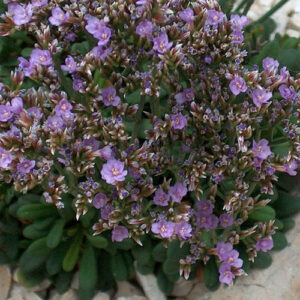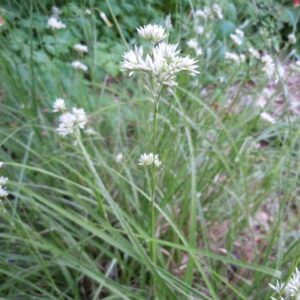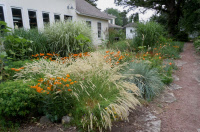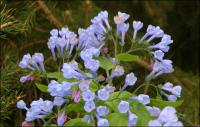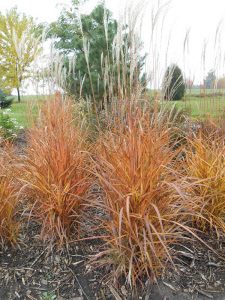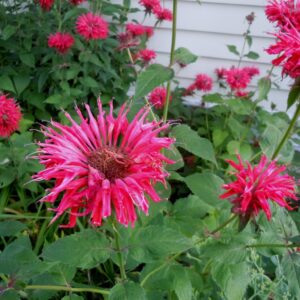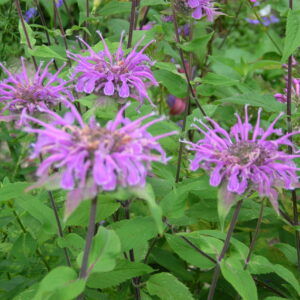Deer Resistant Plants
Showing 89–96 of 163 results
-
Limonium minutum Dwarf statice Z 5-9
All summer long, droves of lavender blossoms above a mini pillow of spoon-shaped, glossy foliage.
OUT OF STOCK
All summer long, droves of lavender blossoms above a mini pillow of spoon-shaped, glossy foliage.
Size: 6-8” x 6-8”
Care: sun in well-drained soil
Native: southeast France on limestone seacliffs
Wildlife Value: deer resistant, salt tolerantDescribed by Linnaeus, 1753. The name Limoniuim comes from the Greek word for meadow.
-
Lobelia siphilitica ‘Alba’ z 4-8
A striking, erect spike of pure white blossoms opening from bottom up. On top club-shaped buds, below trumpet-shapes made of a tube flaring open at the ends with the top of the flare looking like a quarter moon with the circle at the bottom and the lower divided into three, each segment pointed at the ends. Its fresh white blooms stand out in late summer to early fall.
A striking, erect spike of pure white blossoms opening from bottom up. On top club-shaped buds, below trumpet-shapes made of a tube flaring open at the ends with the top of the flare looking like a quarter moon with the circle at the bottom and the lower divided into three, each segment pointed at the ends. Its fresh white blooms stand out in late summer to early fall.
Size: 2-3’ x 1-2’
Care: sun to part shade in moist or moist well-drained soil
Native: The blue form, the species Lobelia siphilitica is native from Connecticut to Wyoming, south to Texas then east to Georgia and all states in between, Wisconsin native.
Wildlife Value: Deer resistant, attracts bees, hummingbirds and some butterflies.This white one is “An albino of occasional occurrence.” Britton, Nathaniel Lord “On the Naming of ‘Forms,’ in the New Jersey Catalogue” Bulletin of the Torrey Botanical Club 17: 121,125. 1890. This may, therefore, be native in the same locations as the blue species or it may not.
-
Luzula nivea Snowy woodrush 5-8
Very unusual & ornamental grass. Dense white flower clusters in June-July. Leaves are evergreen with hairy margins. One of few grasses for shady areas.
Very unusual & ornamental grass. Dense white flower clusters in June-July. Leaves are evergreen with hairy margins. One of few grasses for shady areas.
Size: 24” x 24”
Care: part shade to shade in moist well-drained to well-drained soil.
Native: Central and southern Europe, AlpsNamed by Linnaeus in 1753. Genus name Latin meaning “light.” Nivea means “snow white.” According to Liberty Hyde Bailey the flowers are “useful in dried bouquets.”(1933)
-
Melica ciliata Silky spike melic grass Z 5-9
Ornamental arching white spikes from June through mid-summer. Especially nice for its early bloom, long before most grasses.
Ornamental arching white spikes from June through mid-summer. Especially nice for its early bloom, long before most grasses.
Size: 2' x 12"
Care: full sun in moist well-drained to moist soil.
Native: Eurasia to North Africa
Wildlife Value: Deer resistantMelica is Greek for “sweet grass.” This species collected before 1753.
-
Mertensia virginica syn. Mertensia pulmonarioides Virginia bluebells Z 3-7
Clusters of pink buds turn to sky blue trumpets in May. Ephemeral, disappearing in summer to return next spring.
Available for purchase in Spring only
Clusters of pink buds turn to sky blue trumpets in May. Ephemeral, disappearing in summer to return next spring.
Size: 18" x 10" spreads slowly
Care: Moist well-drained soil in part shade.
Native: N.Y. to Tennessee, west to Kansas, Wisconsin native
Wildlife Value: Provides nectar and pollen to honeybees, bumble and mason bees, as well as Skipper butterflies and Sphynx moths. Deer resistant.
Awards: Royal Horticultural Society Award of Merit.Cherokee cured whooping cough and consumption with Virginia bluebells. Other Natives treated whooping cough, venereal disease, and plain poor health with this. First collected for gardens by John Banister in colonial Virginia C. 1690. Named Mertensia after Franz Karl Mertens (1764-1831), a German botanist who never set foot in America. Grown by both Washington and Jefferson.
-
Miscanthus sinensis subsp. purpurascens syn. Miscanthus ‘Purpurascens’ Flame grass Z 4-9
Flame grass starts in spring tinged with red in the leaves, increasing as summer passes. By fall the leaves turn brilliant orange-red, darkening to burgundy by winter. It retains its color for a few months. Tassel-like inflorescences appear in late summer, opening into creamy plumes by fall. It is upright and clump-forming.
Flame grass starts in spring tinged with red in the leaves, increasing as summer passes. By fall the leaves turn brilliant orange-red, darkening to burgundy by winter. It retains its color for a few months. Tassel-like inflorescences appear in late summer, opening into creamy plumes by fall. It is upright and clump-forming.
Size: 4-5’ x 3-4’
Care: sun to part shade in any soil - sandy to clay soils. Cut back in late winter to spring.
Native: Japan
Wildlife Value: Deer resistant and tolerant of Walnut trees.Miscanthus is Greek meaning stem (“miskos) and flower (“anthos”). Miscanthus mentioned in Man’yoshu, a Japanese anthology of poems written in the 8th century, where it symbolized the melancholy of autumn. This specific plant described by Swedish botanist Nils Johan Andersson (1821-1880) in 1855 in Öfvers. Kongl. Vetensk.-Akad. Förh. 12:167.
-
Monarda didyma ‘Cambridge Scarlet’ Beebalm Z 4-9
Whorls of scarlet tubes & bracts looking like fireworks, in summer
Whorls of scarlet tubes & bracts looking like fireworks, in summer
Size: 3-4' x spreading
Care: sun to part shade in well-drained soil.
Native: N. E. America
Wildlife Value: Checkered white, Fritillary and Melissa blue butterflies relish Beebalm’s nectar.Cherokee used the species medicinally, to cure colic, flatulence, nosebleed, measles, flu, hysteria and to induce restful sleep. Monarda was named in honor of Nicholas Monardes (1493-1588), a Spanish botanist who wrote about plants of the New World. Discovered by John Bartram (1699-1777) being used by colonists in Oswego N.Y. to make tea. Oswego Indians taught the colonists how to make tea from the dried leaves. Bartram sent this Beebalm to Peter Collinson in England in whose garden it grew in 1744. By 1757 its English availability was “nearly universal” among gardeners. During the American Revolution used as a substitute for tea. Grown at America’s 1st botanic garden, Elgin Botanic Garden 1811.This cultivar ‘Cambridge Scarlet’ recommended by Gertrude Jekyll in 1908.
-
Monarda fistulosa Wild bergamont Z 3-9
Whorls of hooded lavender tubes in July - August
Whorls of hooded lavender tubes in July – August
Size: 3-4' x 2' spreading
Care: Sun to part shade any soil.
Native: central U.S., Wisconsin native
Wildlife Value: Checkered white, Tiger swallowtail, Giant swallowtail and Melissa blue butterflies relish Wild bergamot’s nectar. Supports over 70 bee species including Rusty patched Bumble Bee.Used medicinally by many Native tribes- Blackfoot, Cherokee, Chippewa, Choctaw, Crow, Dakota and Flathead. Cherokee: to cure colic, flatulence, nosebleed, measles, flu, hysteria and to induce restful sleep Blackfoot called it “Single-young-Man.” Teton Dakotas boiled the leaves and flowers for medicine to cure abdominal pain. Ho-Chunk boiled the leaves to make a medicine for pimples. Choctaws cured chest pain in children. The Flathead cured colds and sore teeth with Wild Bergamot. HoChunk inhaled fumes in a sweat bath to cure colds. Oneidas made a tea. For the Sioux it was nourishment and a panacea: tea, stomachache, fever, indigestion, sore throats, fainting, whooping cough, wounds, sore eyes, ulcers, and snakebites. First documented by French explorers before 1635. Plant exported to Europe by Tradescant the Younger in 1637. Grown by Washington at Mount Vernon. Today it is a flavor in Earl Grey tea.

